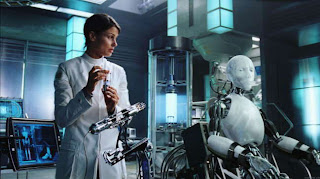 Robots have revolutionized the industrial workplace. Thousands of manufacturers rely on the productivity, high-performance, and savings provided by modern-day industrial automation.
Robots have revolutionized the industrial workplace. Thousands of manufacturers rely on the productivity, high-performance, and savings provided by modern-day industrial automation.
But this six-axis manipulator-style robot, equipped with a controller and teach pendant, took time to evolve. The modern-day industrial robot is the product of many minds and numerous experiments.
THE INDUSTRIAL ROBOT
George Charles Devol is often called the father of robotics. He invented the first industrial robot, the Unimate, in 1954. A few years later, Devol and Joseph F. Engelberger formed the first robot company, Unimation. In 1960, Unimation was purchased by Condec Corporation. General Motors installed the Unimate for die casting handling and spot welding in 1961.
Modern industrial robot arms continued to evolve in the 1960's and 70's. In 1963, the six-jointed Rancho Arm was created to assist handicapped. This was followed by the tentacle arm, designed by Marvin Minsky in 1968. It was able to lift a person and had 12 joints.
It was the 1969 Stanford Arm that eventually led to commercial arm production. The Stanford Arm was one of the first electronically powered, computer-controlled arms. By 1974, it reached a level of sophistication where it could assemble a Model T water pump.
The Stanford Arm was followed by the Silver Arm in 1974. The Silver Arm was created by MIT's David Silver to perform precise assembly using touch and pressure sensors and a microcomputer. These arms led to Victor Scheinman, the inventor of the Stanford Arm, to form Vicarm, Inc. in 1974 to manufacture industrial robotic arms. Scheinman was instrumental in the creation of the PUMA (programmable universal manipulator for assembly) for Unimation. In 1977, the European robot company ASEA, built two sizes of industrial robots.
INFLUENCES
The development of the computer directly influenced the advancement of industrial robotics. The automotive industry was another contributor. In the 1980's, automotive companies showered robotic companies with investments.
But the enthusiasm and funding were not always matched with understanding. General Motors Corporation spent more than $40 billion on new technology in the 1980's. But a lack of understanding led to costly robot fiascos. In 1988, robots at the Hamtramck Michigan plant wreaked havoc - smashing windows and painting one another.
The premature introduction of robotics created financial instability. The robotics industry has only recently regained mid-1980 revenue levels. The American robotics market disappeared as Japanese and European bought up companies.
THE BENEFITS OF INDUSTRIAL ROBOTS:
Automation has dramatically altered factories throughout the globe. Modern industrial robots offer multiple advantages. They have single-handedly transformed products, facilities, and companies. Recent developments have made industrial robots more user-friendly, affordable, and intelligent than ever before.
* Changing the Product: Robots perform applications with greater accuracy, precision and consistency. The product quality improves because of these increases.
* Changing the Environment: Workers no longer have to endure dull, hazardous or taxing tasks. Robots handle toxic substances, repetitive and detail-driven jobs, and lift, carry and select products without tiring or stopping. Robots have prevented many accidents and waste - saving company money. The introduction of robots has led many workers to learn new tasks such as programming.
* Changing the Company: The typical return on investment (ROI) for an industrial robot is substantial and quick. Robots are tireless - leading to increased productivity and manufacturing cost cuts. Management control increases as well.
INDUSTRIAL ROBOTS IN THE FUTURE:
The newest developments in industrial robotics are in artificial intelligence. Future industrial robots will be equipped with advanced learning, vision, and sensory capabilities. Increased application flexibility will lead to increased productivity. Smarter robots will be able to perform complicated tasks perfectly.
From: http://www.used-robots.com/robot-education.php?page=benefits+of+industrial+robots
Welcome to the fun concept for education
Edutainment is a form of education which is designed to be entertaining, in order to keep people interested and engaged. A wide variety of formats can be used to present edutainment, ranging from books to guided tours of zoological parks, and this particular branch of the education world is also extremely profitable. Numerous companies make very large sums of money producing educational materials with an entertaining twist, and in some regions of the world, the rise of edutainment has been criticized by people who fear that it sometimes focuses more on amusing people than teaching them.
The History and Benefits of Industrial Robots
Theme
Business History
Subscribe to:
Post Comments (Atom)










No comments:
Post a Comment